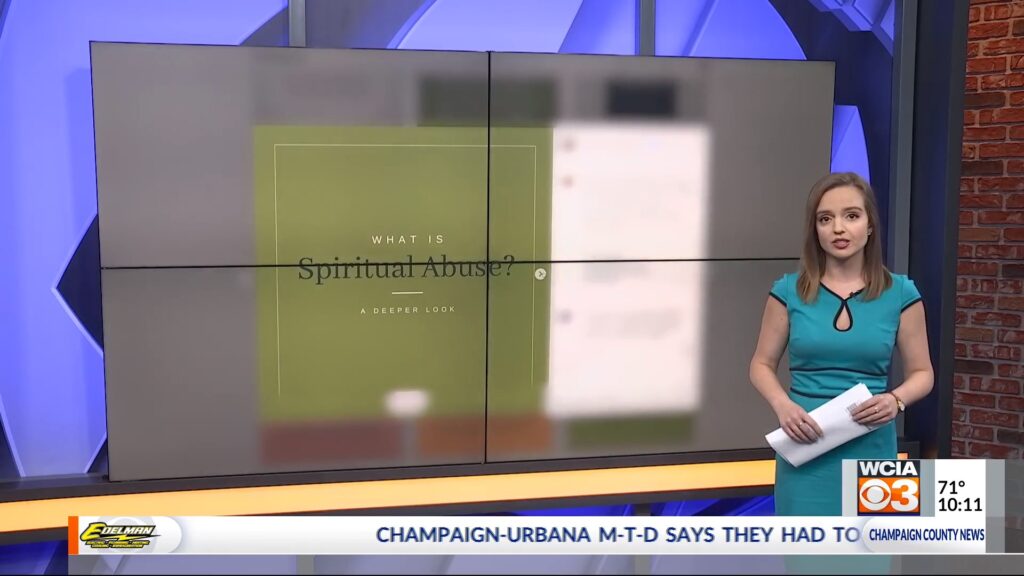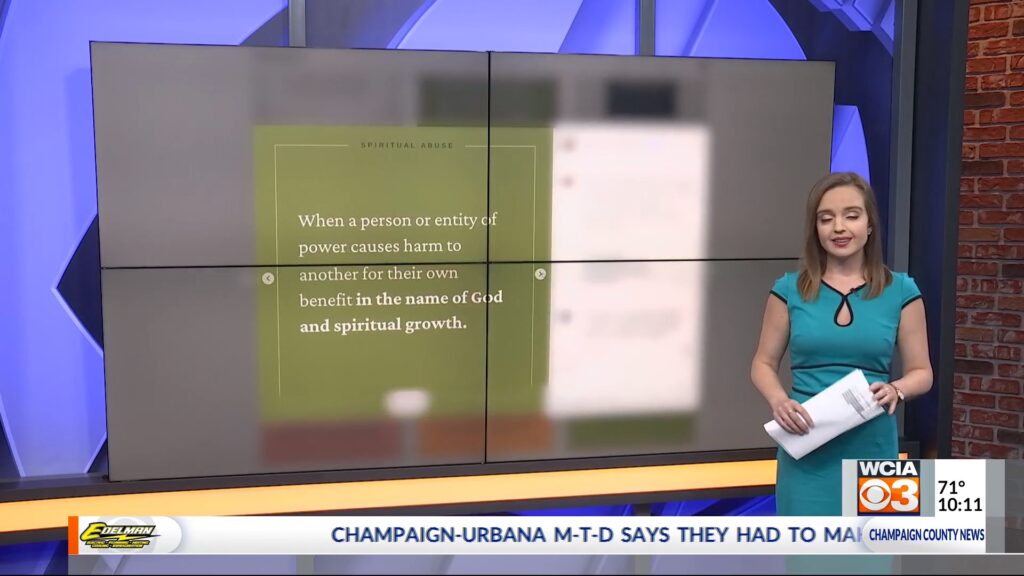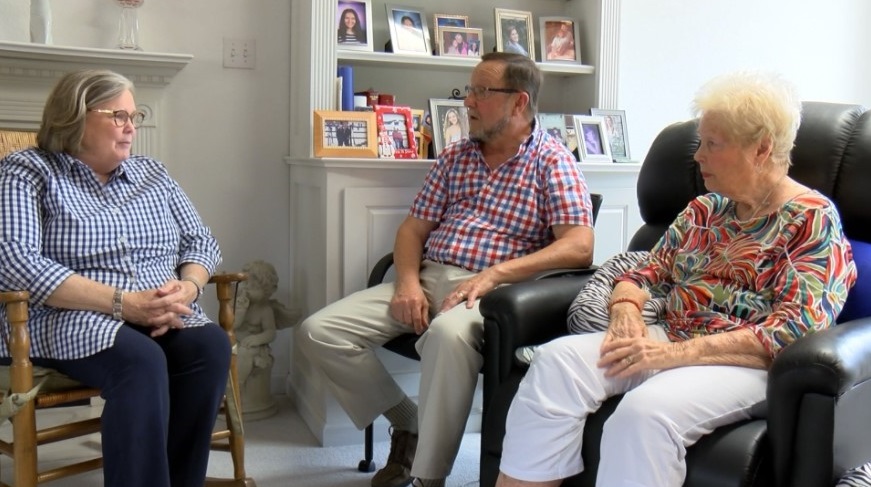SPRINGFIELD (IL)
WCIA [Champaign IL]
August 19, 2021
By Renée Cooper
[Includes ten-minute video with survivor interviews. Photo above: Vicki Schmidt, Pat Fleming, and Sue Lauber-Fleming catch up at the Flemings home outside of St. Louis, Missouri.]
The review of more than a thousand accusations of sexual abuse by Illinois catholic clergy is ongoing.
Former Attorney General Lisa Madigan launched an investigation to uncover the extent of sexual abuse of children in the Catholic Church three years ago. Her office published a preliminary report in December of 2018, and that appears to be the last time the public heard about it until June.
Target 3 investigators requested an update from current Attorney General Kwame Raoul and found out the number of undisclosed cases had doubled since the last report. As the investigation wears on, the Attorney General’s office told us there’s evidence the dioceses were aware of many accusations and disregarded them.
Bishop Thomas Paprocki of the Diocese of Springfield was candid in discussing the investigation.
“Here we are 50 years later, where people involved are dead or gone, and we’re trying to determine, you know, the facts of the case,” he shared.
The Catholic Church continues to work toward healing after years of abuse.
Target 3 spent months gathering the facts and statistics and hearing from those who truly understand the stakes involved in this investigation.

Vicki Schmidt is one of many who can share a firsthand account of abuse by Catholic clergy. She was raised in the Catholic Church at St. John Vianney Parish in Sherman, Illinois.
“A lot of people just think, well, it’s just sex, you know, it’s just sex. Well, no, it’s not,” she shared.
“Abuse is manipulative…It is someone else putting a roadblock up in front of you and not allowing you to live your own life.”
Schmidt said she grew up under the wing of her pastor and abuser at St. John Vianney Parish. She said he sexually assaulted her for more than a decade.
“You know, I just cooperated unwillingly,” she added.
Another survivor told us she witnessed her pastor rape her mother at four years old.
“Nobody should ever have to see what I saw as a four-year-old,” the survivor, Sue Lauber-Fleming, began.
“…And when my mom saw me, she yelled for me to go back up the steps. Well, I tried. I turned around was starting for the stairway and then Monsignor grabbed me and sexually assaulted me.”
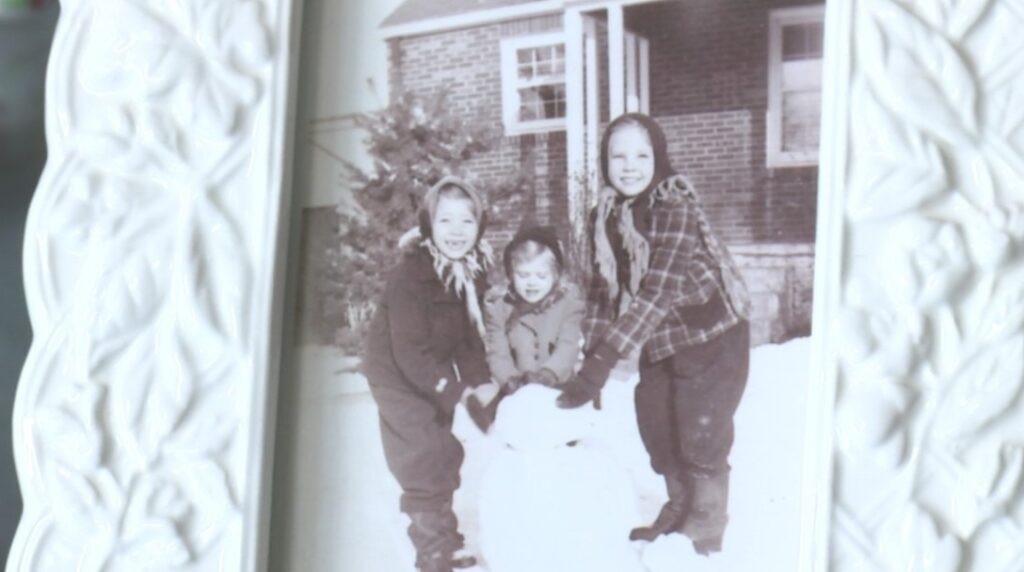
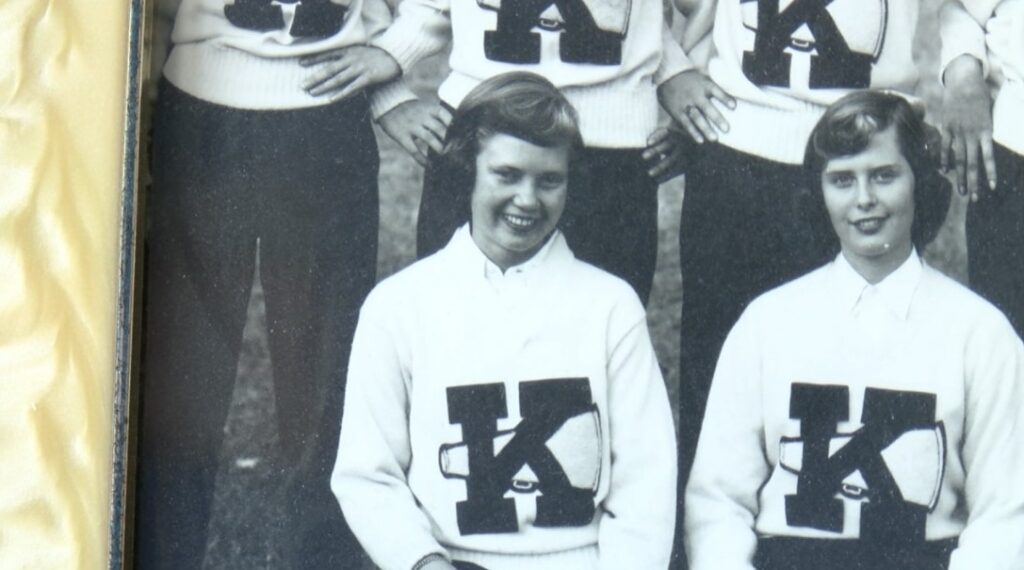
Schmidt, Lauber-Fleming and her husband Pat Fleming met years ago through shared experiences. Since then they’ve published multiple books. Schmidt and Lauber-Fleming’s stories are shared, among others, in the 2007 release, Broken Trust. The book outlined a pattern of abuse left largely in the dark for entire lifetimes.
After Lauber-Fleming shared the story of abuse she remembers so vividly about 80 years later, we asked if she and her mom ever discussed what happened that night.
“Never one word was ever uttered,” she responded.
“I went upstairs and eventually, after a while, my mom came upstairs and she kind of cleaned us up, took a cold washcloth, and washed her face because we were, you know, rather upset. She went over to the refrigerator, opened the freezer and got some ice cream out, and served each of us ice cream. And the sweetness of the ice cream, that sugar, numbed our feelings,” Lauber-Fleming continued.
“So we sat down and folded laundry and ate the ice cream. And never ever, ever did we ever speak a word about it. Now you have to remember, this is 1939, so abuse doesn’t exist. Could priests do any harm? Of course not.”
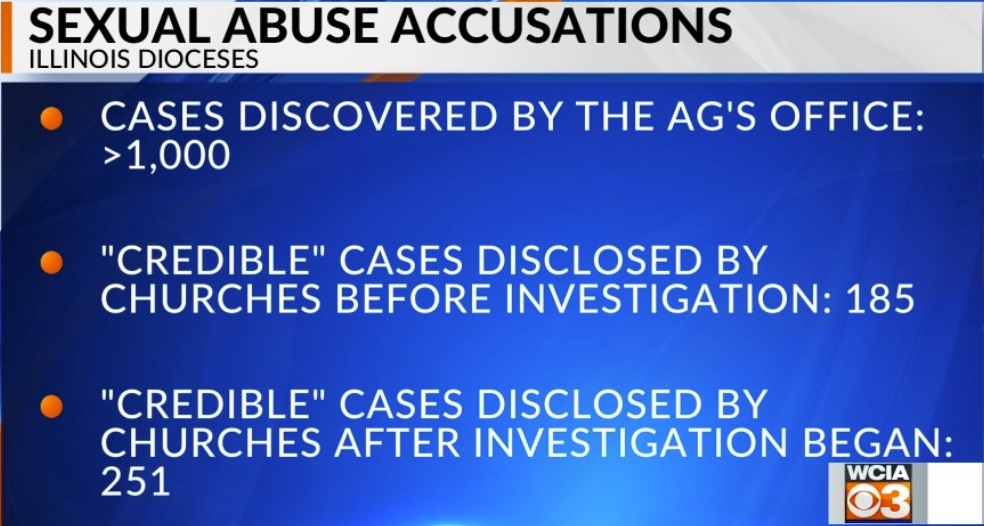
In the investigation spanning three years now, the Illinois Attorney General’s office has uncovered at least a thousand child sexual assault accusations never disclosed by the catholic church.
Some victims reported for the first time through a clergy abuse hotline set up in 2018, according to Raoul. Other cases were discovered in records taken from the offices of the state’s six dioceses.
“There is nothing to prepare you for the types of stories that you hear coming out of such investigations.” the Attorney General said in a June interview.
Illinois clergy have now publicized 251 “credible” abuse cases, a quarter of the attorney general’s findings that date back to the 1950s and ’60s.
The discrepancy, according to Bishop Paprocki, is in the burden of proof.
He used the word “substantiated” to describe the cases the Dioceses of Springfield would publicly report.
“The review board looks at whether or not there is reasonable cause to suspect that the abuse occurred. That’s a lower bar than you have in criminal court,” Paprocki added.
Although, the Attorney General said it took his office’s involvement for the six dioceses to disclose an additional 66 credible cases. Prior to 2018, Illinois dioceses reported 185 cases of sexual abuse of children. As of 2019, the number is 251, meaning about 75% of known reports are considered “not credible” by Illinois Dioceses. That percentage was 82% prior to the most recent disclosure.
“A previous posture of ‘Well, if the priest is dead, there’s nothing to look into,’ does not appreciate that there is with regards to that survivor, right?” Raoul explained.
The attorney general’s office could not give us an exact number of accusations discovered, much less break that number down by diocese. We’re told the data is unavailable while the office rebuilds its network following an April ransomware attack.
“Frankly, just as church authorities sometimes were slow to believe accusers, I think even civil authorities sometimes were,” the Springfield Bishop shared.
To get an idea of how often sexual abuse goes without consequence outside of the Catholic Church, WCIA looked at statistics from the Illinois Department of Children and Family Services. Of the child sexual abuse cases reported to DCFS in the last five years, 73% went unfounded on average.
The diocese of Springfield has recognized two more cases since 2018, according to Bishop Paprocki. The accused are James Patrick O’Hara and Louis Shea.
21 in total are considered credible cases: 15 are deceased, six are no longer in ministry, and three were laicized. The names of the credibly accused are listed on a website created by the diocese shortly after the attorney general’s investigation began.
The most recent accusation of sexual abuse of a minor within the Springfield Dioceses was Eugene Costa in 2004. He was laicized in 2007.
Two clergy members were found guilty in a criminal court and went to jail in the 1980s: Walter Weerts and Alvin Campbell.
“You know, they did, they knew. They knew for quite a few years that, you know, decades, that this was going on. Okay, and they did send priests off for treatment, okay,” Lauber-Fleming’s husband, Pat Fleming shared.
“But you have to give them some grace here, that they didn’t really understand fully the nature of the problem, and what needed to be done to prevent it from ever happening again.”
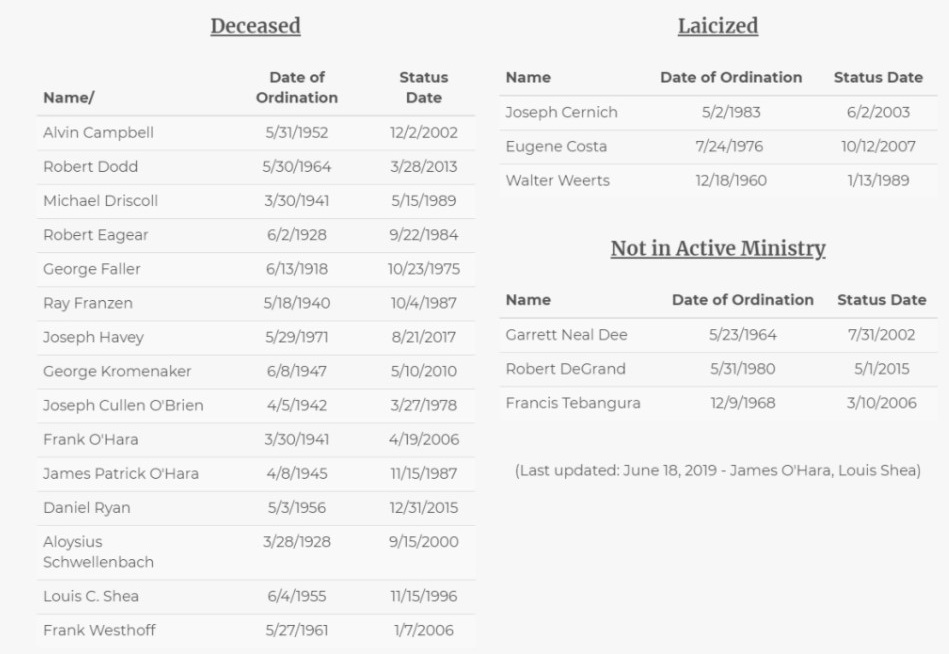
The Catholic Diocese of Peoria listed 43 accusations on its website.
Prior to the investigation, two dioceses had similar web pages, according to Raoul. Now, all six do. Although, it takes a little digging to find the right page.
“We’ve had to have discussions with them about making it prominent enough on their website, and easy enough to navigate to make it meaningful,” Raoul said.
Although Schmidt said she told the Dioceses of Springfield about her abuser more than 20 years ago, his name is not listed on the website.
“It was because the abuse, the sexual abuse started at 18, even though I had been groomed from the age of eight,” she explained.
We asked Paprocki how the church handles clergy abuse of adults:
Renée Cooper: “…That doesn’t have the same zero-tolerance standard for adults?”
Thomas Paprocki: “Well, I’m not aware that we’ve had cases of sexual assault or rape that I’m aware of…”
Cooper: “…I’m sure you’ve heard of Vicki Schmidt…That would be one of those cases within the church.”
Paprocki: ”Mhm.”
Paprocki did not know Schmidt’s abuser. The bishop came to Springfield years after he died.
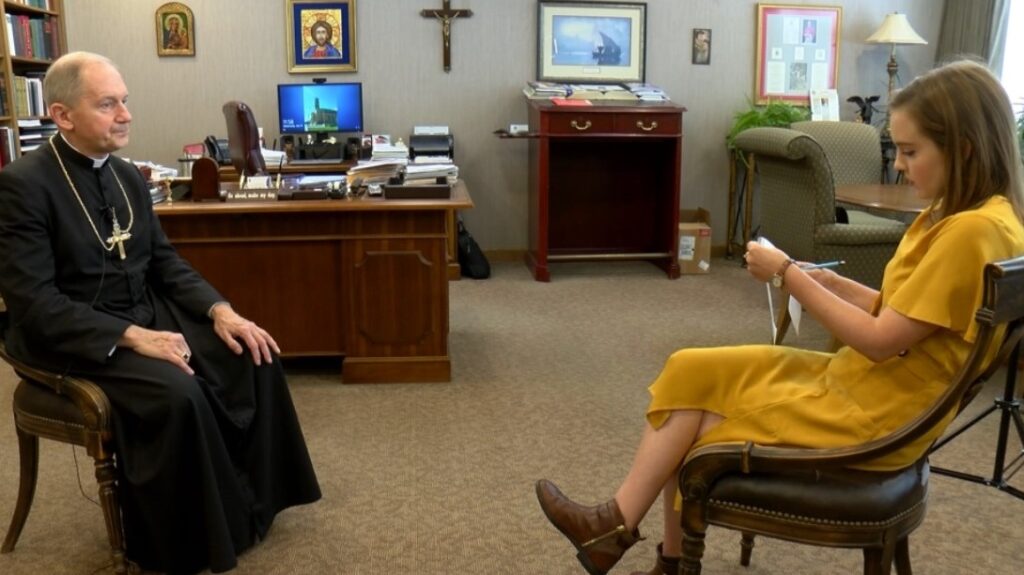
Since then, change has been happening at Illinois dioceses. For example, Paprocki was instrumental in creating a nine-person review board for accusations. It was adopted in Springfield by 2002.
“Most of whom were not priests or religious,” Paprocki added.
Now, if a case is substantiated, clergy members are removed from active ministry, according to the bishop.
Around that time, a zero-tolerance policy became standard for child sexual abuse, making it mandatory to report all allegations to law enforcement and DCFS, unless the allegation was made in a confessional.
In 2010, when Paprocki arrived in Springfield, he implemented a training program for all staff.
“It really trains people to look for signs, you know, to see if there’s some activity here that looks suspicious,” he said.
“That unaddressed trauma, even from decades ago, can still have impact today.”
KWAME RAOUL, ILLINOIS ATTORNEY GENERAL
For years, Lauber-Fleming hid away.
“And it’s like, ‘Well, why?’ Well, yeah, now I know why. If you’re seen you’re hurt, if you’ve seen you get in trouble, you get hurt really big time,” she shared, referring back to the night she was abused.
It wasn’t until she joined cheerleading that she started to come out of her shell.
“It kept me from getting married and starting a family like most of my peers.”
VICKI SCHMIDT, SEXUAL ABUSE SURVIVOR
Schmidt says recovery takes years, decades even. Her story shows this.
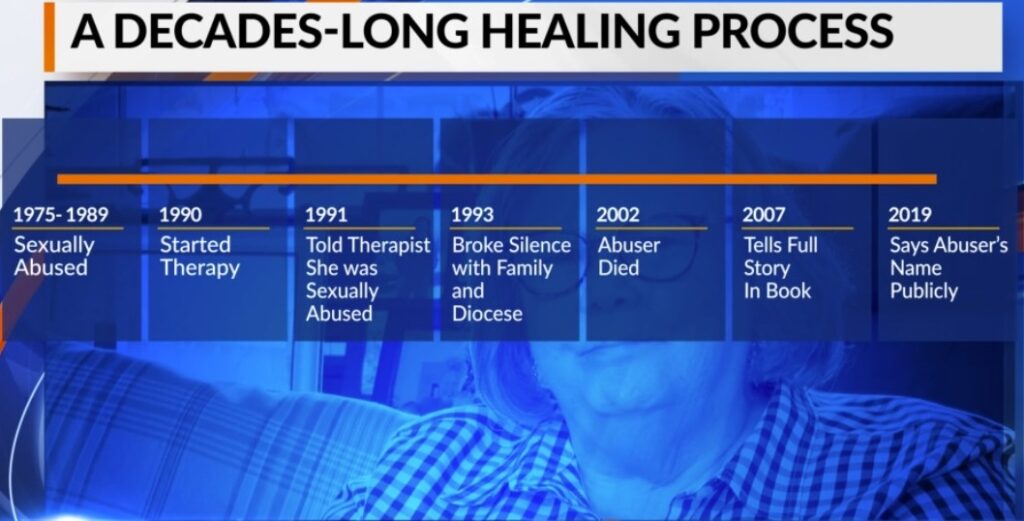
Schmidt was abused roughly between 1975 and 1989. In 1990, she began therapy. Then in 1991, she worked up the courage to tell her therapist she was sexually abused.
In 1993, she told her family and the dioceses.
“I had to stop and, and vomit on the way over because I was just so afraid of the shame and the guilt,” Schmidt remembered.
“They were willing to hear my story but as soon as they heard my story, at that time, they cut off all communication with me.”
In 2007, her full story was told for the very first time, in a book by Lauber-Fleming and Fleming: Broken Trust. Fast forward to 2019, and that’s when Schmidt said her abuser’s name out loud, in public for the first time:
“Peter Mascari,” she told us.
This came seventeen years after his death. He had never been criminally charged.
“A hallmark of our programs for the last 30 years is really reaching out to the victims as well, and making counseling available,” Paprocki continued.
Schmidt said she wants to see that service extended to the families of survivors.
“No one reached out to my parents, no one, and my father was so angry. He was so angry. In fact, the year after that he had a heart attack and a stroke,” she shared.
Schmidt also wanted to see more accountability for priests who abuse vulnerable adults.
“You just can’t abuse people like that and then not and not take responsibility for it,” she concluded. “Especially, especially in a Christian environment.”
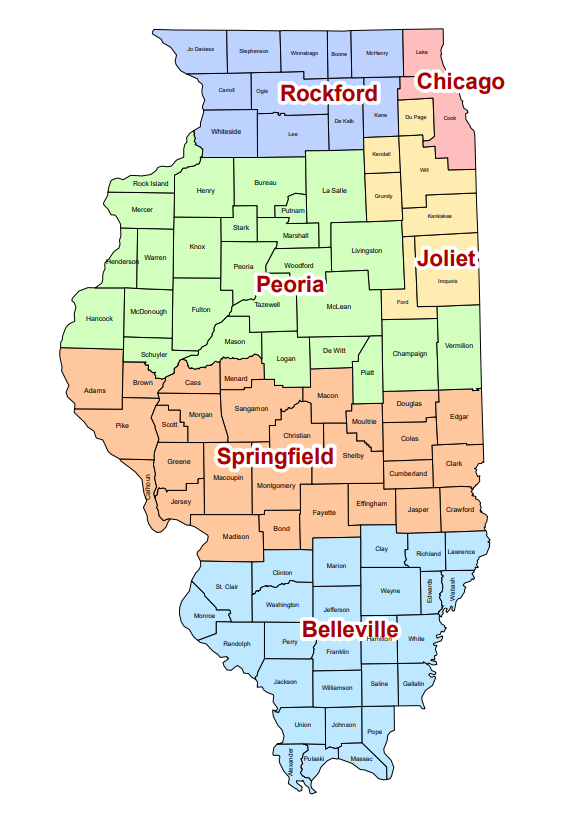
Even with progress, the church will not let its guard down, Paprocki said.
“We need to keep working on it,” he added.
“I think it’s in the interest of the Catholic Church to convey that they’ve taken this seriously, that they’re embracing transparency and disclosure, so as that people can have a restoration of faith in the institution and be confident that this type of history won’t repeat itself,” Raoul said.
Raoul said the investigation will last as long as it takes to make sure every survivor who wants to be heard, is. He expected to finish up last year but pandemic-related litigation slowed the process. The attorney general said he hopes to issue a report to the public with more detailed findings by the end of 2021.
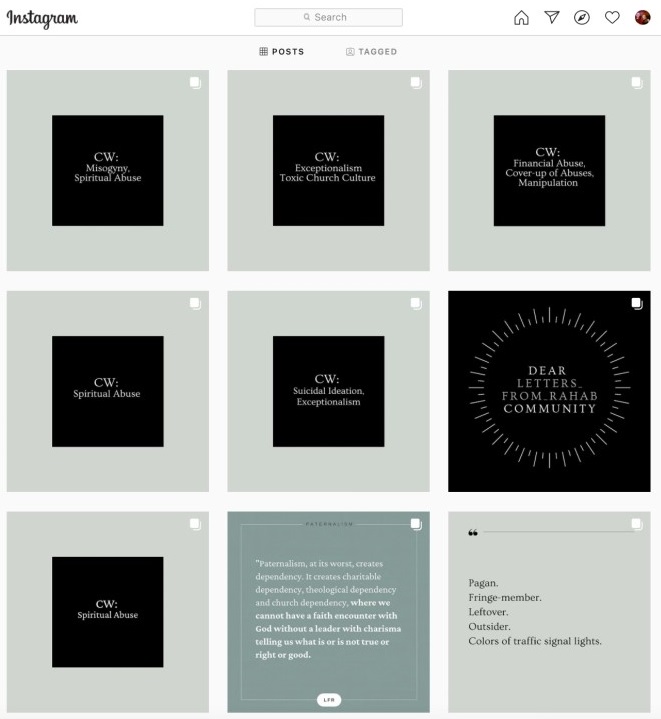
Behind the investigation
The reason the Target 3 investigative team began diving into the attorney general’s investigation in the first place was an Instagram page sent in a tip.
Scroll through the page and you find more than 300 posts from survivors and others about abuse of varying degrees in local churches. In this case, it’s not necessarily Catholic churches being accused, but multiple denominations.
So, we called the attorney general’s office to find out if they’re tracking how often sexual abuse is happening in all religious organizations.
The short answer is, No. We’re told that statistic does not exist.
“I don’t have independent knowledge of systemic abuses and challenges and in the other sort of denominations. That’s not to say that it doesn’t exist,” Raoul responded. “And certainly, if something similar, you know, presents itself by way of allegations, by way of evidence, that drives whether it’s worthy of looking into in the same fashion that we’ve done this investigation.”
“My studies on this [have shown that] other denominations are also dealing with this, Christian and non-Christian denominations are dealing with this problem, as well as outside of churches,” Paprocki added.
“Abuse is abuse, is abuse, is abuse,” Schmidt said. “What’s true in one instance of abuse is true in every other instance of abuse.”
Life after abuse
For survivors out there, Schmidt and the Flemings would tell you healing is possible.
Schmidt said counseling and being a part of writing books helped her discover who she is.
The Flemings went on to work with other victims of abuse, and church leaders who abused minors, for about 18 years as a psychotherapist and a counselor.
All three continue to be active in international conversations surrounding reform and healing, both for victims and abusers, many of whom Pat Fleming says, were abused themselves as children.
